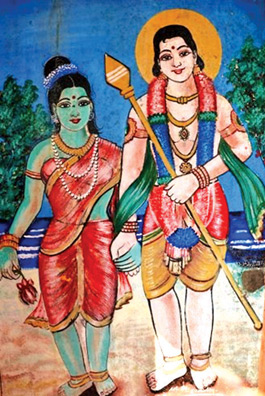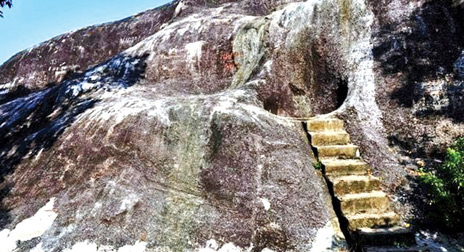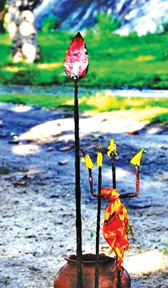|

Painting of Valli Amma and Skanda Kumara at Okanda |
Okanda jungle shrine springs back to life
By Mahil Wijesinghe
A pictorial publication of veteran photographer Nihal Fernando titled
- The wild, the free, the beautiful, published more than two decades ago
has fascinating images of Sri Lanka’s nature, history and wildlife. As
an avid photographer, whenever I get time I turn its pages and enjoy the
pictorial essay. Seeing the images is like reading a classic novel. In
this book, there is a black and white photograph depicting a Hindu
hermit meditating near a waterhole ‘Kema’ on a huge rock boulder near
the Okanda jungle shrine.
Expecting to see the same location photographed decades ago, I
ventured into this sylvan, holy Hindu shrine which is venerated by
thousands of Hindu pilgrims - the Okanda jungle shrine in the deep
corner of Panama in the Yala East National Park. I traced the spot where
Nihal had photographed with the hermit but the place is now modified
with new constructions.
It is not every day that you get a chance to spend a leisurely
evening in a place steeped in history, art, architecture and lore.
My visit to the Okanda jungle shrine with a group of friends was such
a rare coming together of the above factors.
Okanda is not more than 25 km from Panama in the Ampara district.
Situated on the Kumana - Panama Kudumbigala jungle path, the Okanda
shrine is believed to be the location where God Skanda first sailed into
Sri Lanka in a golden boat. The boat, which was turned into a rock,
still stands on the Okanda beach known to all as the ‘Ran Oru Gala’.
Shrine
En route from visiting Kumana (Yala East National Park) we spent the
night at Okanda. The Okanda shrine consists of many buildings used by
pilgrims. These buildings are deserted most of the time during the year
except in July.
|

Two shrines on a rock summit |
|

Kema (water hole) at rock boulder of Okanda |
We spent a night at the edge of the Kumana bird sanctuary and the
jungle shrine with the sounds of wild animals.
The following morning we climbed the Okanda rock boulder which lies
amidst the forest canopy on one side and nestled in a tranquil corner of
the east coast on the other.
On the summit of the rock there lies a small shrine believed to be
dedicated to Valli Amma and in front of the shrine, a beautiful natural
pond that lies with placid water adds beauty to the place.
After a while we reached the top where we took some time to rest and
catch our breath. The view from the pinnacle of the rock was
breathtakingly beautiful as the forest punctured with lagoons and coast
bedecked the surrounding periphery and beyond.
Atop, the chirping of the birds, the rustling of trees and the slight
wind intermingled to produce an array of pleasant sounds.
There are interesting legends associated with the Okanda shrine.
According to one, God Kataragama (Skanda Kumara) came from India with
his servants in two huge canoes and landed at the Okanda beach. The two
canoes used by them turned into stone and is presently known as Ran Oru
Gala which lie at the shore of Okanda.
Playful
He went to Kataragama through the Yala forest, met Valli Amma and had
taken her back to Okanda, got married and spent a fun-filled period of
time (Honeymoon) before going back.
Okanda means playful and happy. Pilgrims from all parts of Sri Lanka
from varied faiths and cultures, seek blessings at the Okanda rock
shrine, especially during its great festival in July.
Held in reverence by many without difference of religion, caste or
creed, the temple’s origin is unknown although the signs of an ancient
monastery are found nearby.
Archaeologists believe the temple being situated near the ancient
Okanda harbour too would have increased its importance with many a
seafaring men seeking its help before and after a journey.
Although the ancient jungle shrine was of much simpler structure and
adornment, the present temple imitates a more Southern Indian Kovil
structure due to its large number of Tamil Hindu devotees.
|

Thrishula at Okanda shrine |
Earnest devotees from Kataragama flock by the thousands, hailing from
all communities, especially Tamil Hindus undertake an annual Pada Yatra
or foot pilgrimage via the Okanda temple and Yala National Park to
Kataragama for the Esala festival in Kataragama. During the height of
LTTE terrorism in the Northern and Eastern provinces in the past few
decades, the Pada Yatra procession was abandoned and greatly affected.
Peace
|

Thrishula at Okanda shrine |
Now thousands of Hindu pilgrims from the North and East throng to
this jungle shrine after a month long Pada Yatra. Pilgrims trek without
fear since peace prevails in the areas. Nearly 30,000 pilgrims from the
Northern and Eastern Sri Lanka arrive in procession at Okanda to
commence a week - long walk through the thick jungle of the Yala
National Park to the temple of God Skanda in Kataragama. The devotees
pray for Lord Skanda’s blessings and assistance, prior to commencing
their journey through the thick jungles of Yala amidst the wild animals.
The ones who walk from afar are those who savour the traditional
pilgrim’s life of sleeping in temples and under the open sky, accepting
whatever alms that strangers may offer, and bearing up under scorching
sun while walking barefoot on searing hot roads, clad only in simple
pilgrim’s garb with a small bundle of offerings and belongings balanced
upon their heads.
All along the way, villagers await their chance to offer alms (Dana)
to the small bands of Swamis.For many pilgrims, the Pada Yatra is a
chance to visit ancient shrines all the way to Kataragama in the company
of devotees. Their long trek takes them to famous temples at Sittandy,
Mamamgam, and Mandur in Batticaloa district.
When the Pada Yatra procession reaches the Ampara District, they
follow the mesmerising East coast via Tirukkovil, Pottuvil, Panama and
Okanda through the Yala National Park to reach Kataragama. Indeed it was
a unique experience with all aspects as modern structures and ancient
buildings blend in an attempt to protect the age-old heritage that
encompassed the Okanda jungle shrine. |

